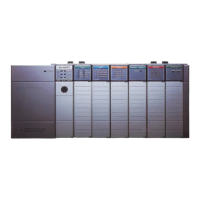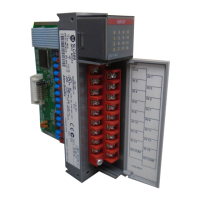32 Discrete I/O Modules
Publication 1746-IN005A-US-P
Fuse Protection and Blown Fuse Diagnostics
This section describes fusing characteristics for the following modules:
• Catalog 1746-OBP16
• Catalog 1746-OVP16
• Catalog 1746-OAP12
Fuse Protection (1746-OBP16 and 1746-OVP16)
The fuse on the 1746-OBP16 and 1746-OVP16 modules (shown on page 33) has
been designed to provide short-circuit protection for wiring only (16 AWG or
larger) to external loads. In the event of a short circuit on an output channel, it is
likely that the transistor associated with that channel will be damaged and the
module should be replaced or a spare output channel used for the load. The fuse
does not provide overload protection. In the event of an overload on an output
channel, it is likely that the fuse will not blow and the transistor associated with
that channel will be damaged. To provide overload protection for your
application, user-supplied fuses should be installed externally and properly sized
to match your individual load characteristics.
Fuse Protection (1746-OAP12)
A fuse is provided on each common of the 1746-OAP12 module (shown on
page 34) for a total of 2 fuses. The fuses are designed to protect the module from
short-circuit conditions. The fuse does not provide overload protection. In the
event of an overload on an output channel, it is likely that the fuse will not blow
and the output device associated with that channel will be damaged. To provide
overload protection for your application, user-supplied fuses should be installed
externally. Recommended fuse for overload protection is SAN-O HT. Select the
fuse rating according to your load. Do not use HT fuses rated higher than 2.0A.
Blown Fuse Diagnostics
If the fuse blows on the 1746-OBP16, -OVP16 or -OAP12, the following occurs:
1. The blown fuse LED will illuminate provided power (5V dc via backplane
and load power via external supply) is applied to the module.
2. A processor error will occur if JP1 connects pins 2 and 3. (See figures on
page 33 and page 34.)

